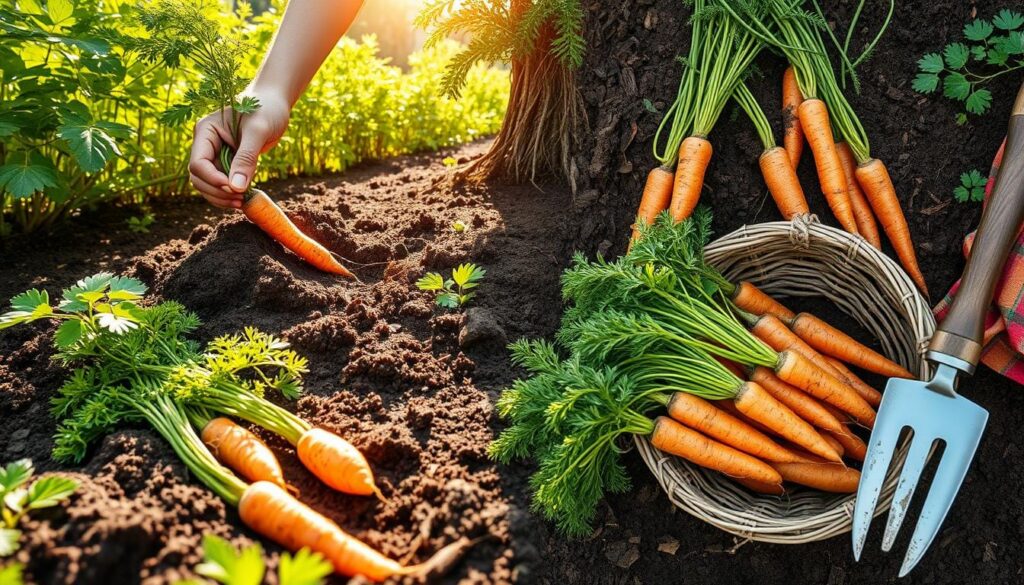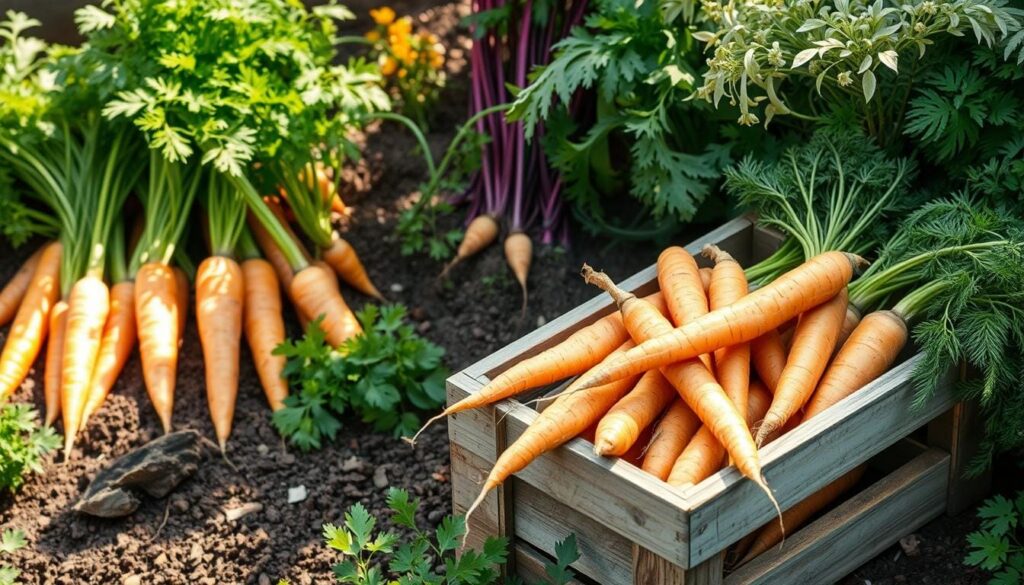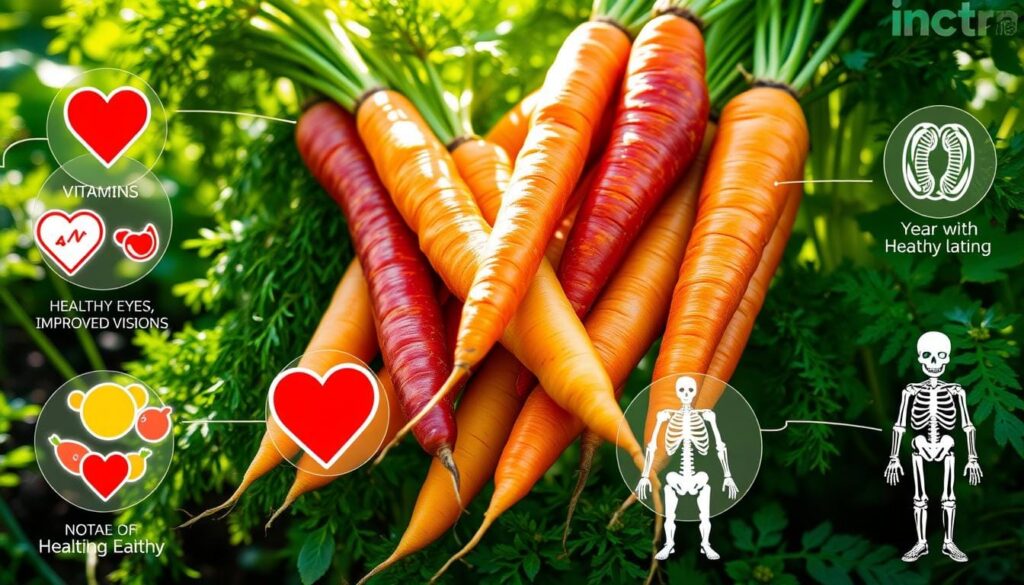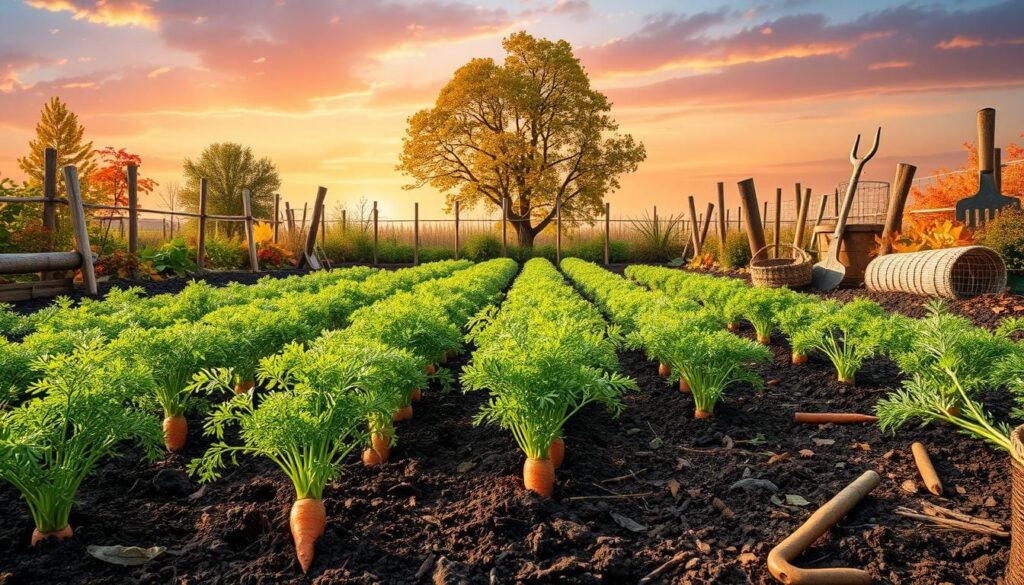Growing carrots has always fascinated me, thanks to my grandmother’s garden. Watching the orange roots grow in the dark soil was magical. Learning when to harvest carrots is more than timing. It’s a way to connect with nature’s rhythm.
Timing is key for harvesting carrots. They usually take about 10 weeks to grow, ready in 60 to 80 days. Our guide will show you how to know exactly when to harvest for the best taste and health.
Carrots need patience and careful care. We’ll teach you how to check the soil and watch for growth. You’ll become a pro at harvesting carrots.
Key Takeaways
- Carrots typically mature in 10 weeks after planting
- Harvest when carrots reach 0.5 inches in diameter
- Optimal soil pH ranges between 6.0 and 6.8
- Water requirements are approximately 1 inch per week
- Different varieties have slightly different harvest times
Understanding Carrot Growth Stages
Growing carrots is a journey that needs patience and careful attention. It transforms tiny seeds into tasty, healthy vegetables. Knowing the growth stages helps gardeners get the best harvest and spot when carrots are ready.
The journey from seed to harvest takes 50 to 100 days. This depends on the carrot type and growing conditions. Let’s look at the main stages of carrot growth:
Germination Process
Carrot seeds are amazing in their growth. They start growing in 14 to 21 days, best in soil between 55°F and 65°F. Gardeners should remember:
- Seeds need steady moisture
- Soil between 40°F and 85°F helps germination
- Seeds stay viable for about 3 years
Seedling Development
After germination, seedlings start changing. The first true leaves appear 1.5 to 3 weeks later. This stage needs careful management:
- Thin seedlings to 2-4 inches apart
- Keep the soil moist
- Give them full sun (6-10 hours daily)
Maturation Process
The last stage is root growth. Look for these signs of maturity:
- Roots should be 6-8 inches long
- Soil should be 60°F to 75°F
- Growth takes about 70-80 days
“Patience is key in growing the perfect carrot – each stage brings you closer to a bountiful harvest.”
| Growth Stage | Duration | Key Requirements |
|---|---|---|
| Germination | 14-21 days | Soil temp 55-65°F, consistent moisture |
| Seedling | 3-4 weeks | Full sun, proper spacing |
| Root Development | 70-80 days | Stable temperatures, rich soil |
By understanding these growth stages, gardeners can successfully cultivate delicious, crisp carrots from seed to harvest.
Ideal Timing for Harvesting Carrots
Knowing when to pick carrots is key for gardeners wanting the best taste and nutrition. Our carrot crop calendar helps you plan the perfect harvest time.
Carrot harvesting varies by type. Each variety grows at its own pace, making timing both an art and science.
General Harvesting Timeline
Carrots usually take 50 to 80 days to mature. Here’s a quick guide to when to harvest:
- Baby carrots: Ready in 30-50 days
- Nantes varieties: Harvest around 50-60 days
- Standard carrots: Peak harvest at 60-75 days
- Storage carrots: May take up to 80-110 days
Factors Affecting Harvest Time
Several things affect when to pick carrots:
- Soil temperature: Ideal range between 55°F to 65°F
- Variety selection
- Planting season
- Growing conditions
“The secret to perfect carrots is patience and understanding their growth cycle.” – Gardening Expert
| Carrot Type | Days to Mature | Best Harvest Indicators |
|---|---|---|
| Nantes | 50-60 days | 1/2 inch diameter, sweet flavor |
| Danvers | 70-80 days | 1 inch diameter, sturdy roots |
| Chantenay | 65-75 days | Broad shoulders, rich color |
Our carrot crop calendar advises to watch your plants closely. Look for greens 4-6 inches tall and shoulders 3/4 to 1 inch in diameter for the best harvest.
Signs That Carrots Are Ready for Harvest
Knowing when your carrots are at their best is key for great taste and texture. Spotting the signs of maturity lets gardeners pick the right time. This ensures a tasty and healthy crop.
Our guide will show you how to spot the best time to harvest carrots. We’ll cover how to observe and use simple methods.
Visual Indicators of Carrot Maturity
Here are the main visual signs that carrots are ready:
- Carrot greens reaching 10-12 inches in height
- Deep, vibrant orange color developing
- Shoulder diameter between 3/4 to 1 inch wide
- Tops of carrots becoming visible above the soil
Texture and Size Assessment
When checking if carrots are ready, look at these factors:
- Gentle soil excavation to check root diameter
- Checking for a firm, crisp texture
- Ensuring carrots measure between 1-1.5 inches at the shoulder
Soil Conditions to Consider
Soil moisture and temperature are key for harvesting carrots. Soil that drains well helps carrots grow and makes them easier to pull.
“The secret to perfect carrots lies in understanding their growth environment and harvest timing.” – Experienced Gardener
Most carrots take 60-80 days to mature. Some can be ready in as little as 50 days. Pro tip: For sweeter carrots, harvest after a light frost. It boosts their natural sugars.
Harvesting Techniques for Carrots
Learning how to harvest carrots is key. You need the right tools and techniques. Our guide will show you how to pick your carrots without harming them.

Harvesting carrots is an art. It requires careful preparation and gentle handling. Knowing when to harvest is important to keep your carrots fresh.
Essential Tools for Harvesting
To harvest carrots well, you’ll need a few tools:
- Garden fork or spading fork
- Soft-handled trowel
- Gardening gloves
- Bucket or harvest basket
Best Practices for Harvesting Carrots
Before you start, water the soil well. This makes it easier to pull out the carrots. Here’s how to do it right:
- Harvest in the cool morning or evening
- Loosen the soil around the carrot tops gently
- Hold the carrot leaves near the crown
- Pull with steady, gentle pressure
“The key to perfect carrot harvesting is patience and gentle technique.”
Check if your carrots are ready by their size. Ideal harvesting occurs when carrots reach about 1 inch wide at the top. Most varieties take 65-70 days, but some can take up to 100 days.
| Carrot Variety | Days to Maturity | Harvest Size |
|---|---|---|
| Nantes | 60-65 days | ½-1 inch diameter |
| Danvers | 75-80 days | 1-1.5 inches diameter |
| Baby Carrots | 30-50 days | ½ inch diameter |
Timing is everything when harvesting carrots. Look for visual cues like leaf height and root diameter for the perfect harvest.
Storage Conditions After Harvest
After growing your carrots, it’s key to store them right to keep them fresh. Knowing how to store them well helps you enjoy your carrots for longer. This way, you can make the most of your carrot harvest all season long.
Good storage is as important as growing your carrots. The right storage can make a big difference in how long and how tasty your carrots stay.
Optimal Storage Temperatures
The best temperature for storing carrots is between 32–38°F (0–3°C). This keeps them crunchy and full of nutrients. If it’s too hot or cold, they won’t last as long.
| Storage Condition | Temperature | Relative Humidity | Expected Shelf Life |
|---|---|---|---|
| Refrigerator Storage | 32-38°F | 98% | 5 months |
| Root Cellar | 32-40°F | 95% | 4-5 months |
| Cool Dry Storage | 50-60°F | 60% | 2-3 months |
Long-Term Storage Techniques
- Remove carrot tops before storage to prevent moisture loss
- Store in perforated plastic bags in the refrigerator’s crisper drawer
- Layer carrots in moist sand for root cellar preservation
- Check stored carrots every 1-2 weeks for signs of decay
- Use smaller roots first to minimize waste
By using these storage tips, gardeners can enjoy their carrots for months. This makes the most of your harvest.
“Proper storage is the secret to preserving the crisp, sweet flavor of freshly harvested carrots.” – Gardening Expert
Pro tip: Always pick mature, undamaged carrots for long-term storage. This ensures the best taste and quality.
Varieties of Carrots and Their Harvest Times
Exploring the world of carrot varieties is key for a successful harvest. Each type grows at its own pace, giving gardeners many choices for their gardens.

Carrot varieties vary a lot in how they grow and when they’re ready to pick. We’ll look at three common types that many gardeners grow.
Nantes Varieties: Quick and Sweet
Nantes carrots grow fast and taste sweet. They are:
- Mature in 50-70 days
- Smooth and blunt at the end
- Perfect for eating fresh and in short seasons
Danvers Varieties: Storage Champions
Danvers carrots are great for growing and keeping. They have:
- Mature in 75-85 days
- A conical shape with broad shoulders
- Are best for storing and processing
Chantenay Varieties: Hardy Garden Performers
Chantenay carrots do well in tough soil and give reliable harvests. They are:
- Mature in 70-80 days
- Short and thick, good for heavy soils
- Perfect for canning and cooking
“Choose your carrot variety based on your garden’s unique conditions and your culinary preferences.” – Gardening Experts
| Variety | Days to Maturity | Best Use |
|---|---|---|
| Nantes | 50-70 | Fresh eating |
| Danvers | 75-85 | Storage |
| Chantenay | 70-80 | Cooking |
Knowing about these varieties helps gardeners plan their carrot season. This way, they can get the most out of their harvest.
Common Mistakes When Harvesting Carrots
Growing carrots needs precision and careful attention. Many gardeners face challenges during harvest that can affect the quality and taste. Knowing these common mistakes can help you grow better carrots.
We’ve found several key mistakes that can ruin your carrot harvest. By avoiding these, you’ll have a better chance of growing tasty and plentiful carrots.
Overlooking Soil Moisture Challenges
Soil moisture is key for a good carrot harvest. Gardeners often make mistakes like:
- Harvesting carrots in dry or soggy soil
- Not keeping soil moisture steady during growth
- Not checking soil before pulling carrots
Pro tip: Keep soil moist, but not too wet, during the early growth stages.
Timing Harvest Too Early or Late
Timing is everything for the best carrot quality. Harvesting too soon can lead to:
- Less flavor
- Smaller roots
- Less nutrients
“Patience is key when growing carrots. The right harvest time can make all the difference in taste and texture.” – Experienced Gardener
Harvesting too late has its own problems, like:
- Woody texture
- Less sweetness
- Potential root cracking
Most carrots are ready in 60 to 80 days. Fast-growing types like ‘Nantes’ can be ready in 50 days. Storage carrots might take up to 110 days.
Avoiding these mistakes will help you have a successful carrot harvest. Your carrots will be delicious and satisfying.
Nutritional Benefits of Carrots
Carrots are packed with nutrients that boost health. Harvesting them at the right time ensures you get the most benefits. Let’s dive into the amazing nutrients found in these vibrant orange veggies.

Carrots are full of vitamins and minerals that are good for you. They are a true superfood. Here’s a look at the key nutrients in carrots.
Vitamin and Mineral Content
- Vitamin A: Provides 73% of daily requirements
- Vitamin K: Offers 9% of daily needs
- Potassium: Delivers 8% of daily intake
- Vitamin C: Contributes 5% of daily value
Comprehensive Nutritional Profile
| Nutrient | Amount per Serving |
|---|---|
| Calories | 25 |
| Carbohydrates | 6g |
| Fiber | 2g |
| Protein | 0.5g |
Health Benefits of Consuming Carrots
Knowing when to harvest carrots is key to their health benefits. Carrots offer many advantages for your well-being.
- Support eye health through beta-carotene
- Boost immune system function
- Help manage blood sugar levels
- Potentially reduce cancer risks
- Promote heart health
“Carrots are nature’s multivitamin, delivering a powerful punch of nutrition in every bite.” – Nutrition Expert
Choosing the right time to harvest carrots is important. Pick them when they’re fully grown but not too ripe. This way, you get the most nutrients.
Companion Planting for Carrots
To get the most out of your carrot season, you need to plant smart. Our guide will show you how to make a garden that helps your carrots grow well. It will also make all your plants healthier.
Companion planting is a great way to boost your carrot crop. By picking the right plants to grow together, you can keep pests away. You can also make the soil better and grow more food.
Best Partner Plants for Carrots
- Onions: Repel carrot flies and protect your crop
- Tomatoes: Use the space around your garden well
- Marigolds: Keep pests away with their strong smells
- Dill: Attracts good bugs
- Cilantro: Helps control pests
Plants to Strategically Avoid
Some plants can hurt your carrots and should be kept far away:
- Other root vegetables that take up too much space
- Apiaceae family members that attract the same pests
- Plants that need a lot of nitrogen
“Successful companion planting is about creating a balanced garden ecosystem.” – Gardening Experts
When planning your carrot season, think about how much space they need. Keep carrots and companion plants at least 8-12 inches apart. This helps them grow well and prevents them from fighting over resources.
By using these planting tips, you’ll make a strong garden. It will help your carrots grow well and give you a bigger harvest.
Seasonal Considerations for Carrot Harvesting
Growing carrots needs careful planning for different seasons. Knowing when to harvest carrots can greatly improve your garden’s success. Each season brings its own challenges and chances for growing these tasty root veggies.

Carrots can be grown all year with the right planning. Our guide will teach you the best harvesting methods for every season. Learn how to pick carrots at the perfect time.
Spring vs. Fall Harvesting Strategies
Choosing when to pick carrots depends on the season:
- Spring planting starts 2-3 weeks before the last frost
- Fall carrots are sweeter and more flavorful
- Mid-October is the best time for sweetness and storage
Climate Adaptations for Carrot Growth
Carrots grow differently in various climates. Here are some tips for each:
| Climate Zone | Planting Recommendation | Harvest Timing |
|---|---|---|
| Cool Temperate | Early Spring/Late Summer | 70-80 days after planting |
| Warm Temperate | Fall/Winter Planting | 60-70 days after planting |
| Subtropical | Winter Months | 55-65 days after planting |
“The secret to successful carrot cultivation lies in understanding your local climate and adapting.
Pro tip: Carrots grow best in loose, well-draining soil and cooler temperatures for sweetness.
Post-Harvest Processing of Carrots
After growing your carrots, it’s important to process them right. This keeps them fresh and extends their shelf life. Our tips will help you keep your hard work delicious.
When you harvest carrots, handle them with care. We’ll show you how to clean, prepare, and store them.
Cleaning and Preparing for Storage
Cleaning is the first step in processing. Here’s how to do it right:
- Gently remove soil using soft brushes
- Trim carrot tops, leaving about 1 inch of stem
- Avoid washing carrots until immediate use
- Inspect for any damage or blemishes
Preservation Methods
Knowing how to store carrots is key. Our research shows the best conditions:
| Temperature | Humidity | Storage Duration |
|---|---|---|
| 0-2°C | 90-95% | Up to 6 months |
| 4°C | 80-90% | 1-2 months |
| 20°C | 60-70% | 2-3 days |
For long-term storage, try these methods:
- Refrigeration
- Freezing
- Dehydration
- Canning
“The key to preserving carrots is maintaining optimal temperature and humidity conditions.” – Agricultural Preservation Expert
Pro tip: Cool your carrots to 0°C within 24 hours of harvesting. This maximizes storage and prevents quality loss.
Enhancing Carrot Flavor Over Time
Gardeners can make carrots sweeter by knowing how the environment affects their taste. We explore how to improve carrot flavor, including signs of maturity and the best growing season.
Carrots get sweeter as they grow, thanks to temperature and environment. They make sugars through photosynthesis. This sweetness grows after they get a light frost.
Impact of Frost on Carrot Sweetness
Cool weather changes carrots in a good way. When it gets cold, carrots turn starch into sugar, making them sweeter. The best taste happens when:
- Days are warm
- Nights are cool
- Light frosts have occurred
Soil Quality Enhancements
Soil quality is key for tasty carrots. Gardeners should focus on a few important soil factors:
| Soil Characteristic | Optimal Range | Impact on Flavor |
|---|---|---|
| pH Level | 6.0 – 6.8 | Promotes nutrient absorption |
| Water Consistency | 1 inch per week | Supports steady sugar production |
| Fertilization | 5-6 weeks after sowing | Encourages robust root development |
Pro tip: Mulch your carrot rows with 18 inches of shredded leaves after the first hard frost to preserve sweetness and protect the harvest.
“The secret to the sweetest carrots is patience and understanding nature’s subtle flavor-enhancing techniques.” – Experienced Gardener
FAQs About Carrot Harvesting
Growing carrots can be very rewarding for gardeners. Many questions come up when it’s time to harvest. Let’s look at some common questions about when to pick carrots and how to do it right.
Figuring out when to pick carrots can be tricky. Our guide will help you understand carrot cultivation and harvesting better.
How Do You Know When to Pull Carrots?
To know when to harvest carrots, look for these signs:
- Check the diameter of the carrot shoulder – typically 3/4 to 1 inch wide
- Look for a rich, deep orange color
- Observe the top of the carrot peeking through the soil
- Consider the days to maturity for your specific variety (usually 65-100 days)
“The secret to perfect carrots is patience and careful observation.” – Experienced Gardener
What Happens if You Leave Carrots in the Ground Too Long?
Leaving carrots in the ground too long can cause problems:
- Roots become woody and less sweet
- Potential split or misshapen carrots
- Increased risk of pest damage
- Reduced overall quality of the harvest
It’s best to harvest when carrots are just right in size and flavor. Timing is everything when you pick carrots! Most gardeners harvest around 10 weeks after planting. But, local conditions can change things.
Pro tip: Carrots can get sweeter after a light frost. So, don’t pull them too early in the season. The cool weather makes them taste even better.
Conclusion: Enjoying Our Carrot Harvest
Our journey through carrot harvest techniques has given gardeners key insights. We’ve learned about growth stages and how to harvest carrots perfectly. This knowledge helps grow delicious, healthy carrots in home gardens across the United States.
Timing and careful observation are key for a successful carrot harvest. Carrots need 70 to 80 days to grow. Gardeners should watch plant growth, soil conditions, and pick the right time to harvest. The best size for harvesting is between 1/2 to 3/4 inches for the best taste.
Gardeners should follow the seasons for growing carrots. Whether planting in spring or fall, knowing the right temperatures and growth needs is important. By using these tips, your garden will become a place of fresh, homegrown carrots.
Recap of Best Practices
Our exploration showed the importance of soil, moisture, and harvesting techniques. Harvesting in the morning, avoiding frost, and storing carrots right are key to success.
Encouragement for Future Growing Seasons
Every growing season is a chance to get better at gardening. With patience, practice, and the knowledge from this guide, your carrot harvests will keep getting better. You’ll enjoy fresh, nutritious vegetables from your garden.

